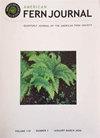Diversity Patterns of Neotropical Ferns: Revisiting Tryon's Centers of Richness and Endemism
IF 0.7
4区 生物学
Q4 PLANT SCIENCES
引用次数: 10
Abstract
Abstract. Almost fifty years ago Dr. Rolla M. Tryon investigated the patterns of neotropical fern diversity and discovered that sites of exceptional richness and endemism are found in five predominantly montane regions. Here, we revisit these sites with the aid of contemporary methodologies. We integrate phylogenetic, ecological, climatic, and occurrence data to better understand what factors contribute to the patterns of fern diversity throughout the neotropics. With this dataset we are able to reassess Tryon's neotropical hotspots fifty years later and take one step closer to understanding the processes governing the distribution of fern species. We recover six hotspots of neotropical species richness and endemism that closely mirror those delineated by Tryon. Like Tryon, we find that hotspots are found predominantly in montane regions with more climatic space compared to surrounding areas. Patterns of species richness and lineage diversification can largely be explained by the extent of available habitats, especially in association with montane ecosystems. We also show that patterns of species assemblages across the neotropics are largely dictated by distance and elevation. In synthesis, we propose that, in addition to migration and persistence of relictual lineages, patterns of species richness and endemism in the neotropics are driven by in situ speciation in montane regions.新热带蕨类植物的多样性模式:重新审视Tryon的丰富性和地方性中心
摘要大约50年前,Rolla M.Tryon博士调查了新热带蕨类植物的多样性模式,发现在五个以山地为主的地区发现了异常丰富和特有的地点。在这里,我们借助当代方法重新访问这些网站。我们整合了系统发育、生态、气候和发生数据,以更好地了解是什么因素导致了整个新热带地区蕨类植物的多样性模式。有了这个数据集,我们能够在50年后重新评估Tryon的新热带热点地区,并离了解蕨类物种分布的过程又近了一步。我们发现了六个新热带物种丰富度和特有性的热点,这些热点与Tryon所描绘的热点非常相似。与Tryon一样,我们发现热点地区主要分布在与周围地区相比气候空间更大的山地地区。物种丰富度和谱系多样化的模式在很大程度上可以用可用栖息地的范围来解释,尤其是与山地生态系统有关的栖息地。我们还表明,新热带地区的物种组合模式在很大程度上由距离和海拔高度决定。在综合中,我们提出,除了残余谱系的迁移和持久性之外,新热带地区的物种丰富度和特有性模式也是由山地地区的原位物种形成驱动的。
本文章由计算机程序翻译,如有差异,请以英文原文为准。
求助全文
约1分钟内获得全文
求助全文
来源期刊

American Fern Journal
生物-植物科学
CiteScore
1.20
自引率
0.00%
发文量
28
审稿时长
6 months
期刊介绍:
The American Fern Journal is a peer-reviewed journal focused on the biology of ferns and lycophytes.
 求助内容:
求助内容: 应助结果提醒方式:
应助结果提醒方式:


